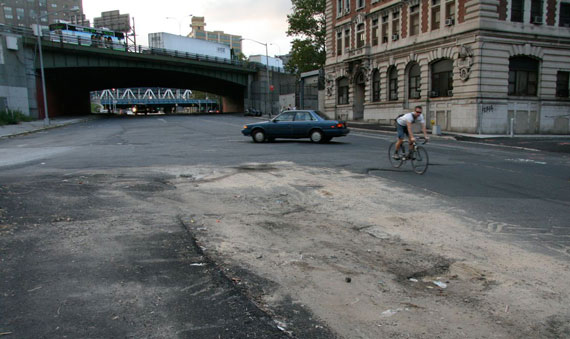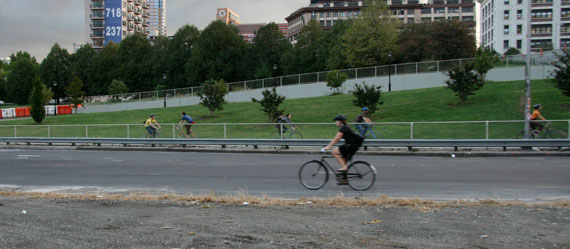Manhattan Bridge Bike Path Mired for Years in Construction Bureaucracy

Construction of the Sands Street bike path was promised to begin in 2006…
The slow pace of safety improvements for downtown Brooklyn streets became tragically apparent earlier this month when eight-year-old Alexander Toulouse was killed by a postal truck on Livingston Street. A $5 million traffic calming project for the area, unveiled in 2007, is not the only livable streets initiative to suffer delays. The Sands Street bike path, a physically protected approach to the Manhattan Bridge, has languished behind schedule for years, held up in the city’s construction bureaucracy. The project serves as a prime illustration that livable streets hinge not just on DOT, but on other, more obscure city agencies as well.

…here’s how Sands Street looks today.
In April 2005, Noah Budnick of Transportation Alternatives was riding on Sands Street, after exiting the Manhattan Bridge, and crashed on a dangerous stretch where cyclists often have to contend with deeply pock-marked pavement and cars accelerating onto the Brooklyn Queens Expressway. He sustained severe head trauma, requiring hospitalization and a prolonged recovery.
 Two years earlier, Budnick had joined other Brooklyn bike advocates in calling on the Department of Transportation to improve the safety of the very same bridge approach. Borough President Marty Markowitz and City Council member David Yassky pledged support (right). DOT, under the leadership of commissioner Iris Weinshall at the time, did announce plans for a protected bike path on Sands Street — two months after Budnick’s crash. Construction would start in 2006, the agency said.
Two years earlier, Budnick had joined other Brooklyn bike advocates in calling on the Department of Transportation to improve the safety of the very same bridge approach. Borough President Marty Markowitz and City Council member David Yassky pledged support (right). DOT, under the leadership of commissioner Iris Weinshall at the time, did announce plans for a protected bike path on Sands Street — two months after Budnick’s crash. Construction would start in 2006, the agency said.
This June marked the third anniversary of that announcement, and construction on the Sands Street bike path has still not begun. (A contractor is slated to begin work in October.) Last year, a new team took the reins at DOT and dramatically accelerated the pace of bike improvements. But getting this critical safety measure through the different stages of government approval has been slow as molasses. Why?
Capital projects like Sands Street are carried out by the city’s Department of Design and Construction, which works with contractors to see DOT’s designs through to completion.
The initial DOT design for Sands Street called for a two-way bike path, running along a raised median, protected from car traffic by a fence on both sides. Transportation Alternatives and Community Board 2 lobbied DOT to replace the fence with bollards. A continuous fence, they said, would have kept residents of nearby Farragut Houses from walking across the street midblock, in addition to posing a danger to cyclists by making it harder for them to exit the bike path in case of an emergency. A bike path design using bollards was adopted.
DOT and DDC attempted to fold the bike path project into an existing contract where work was already underway, the reconstruction of Flushing Avenue. DDC put out the $40 million Flushing Avenue bid in 2003. DOT and DDC initially stated that the contractor, Bronx-based firm Demicco Bros., would not agree to incorporate the bike path work into the project.

On Sands Street, cyclists contend with broken pavement and cars getting onto the BQE.
Frank Demicco of Demicco Bros. says his firm was never officially told to do the work. "It was something that was just talked about," he said. The city did not go so far as to issue a change order instructing Demicco to build the bike path. "There’s no items in the contract for me to construct that, so it’s really illegal for them to give me work without issuing a change order, and the change order might have been too expensive, or whatever they thought. That’s probably why they went that route." The city is reluctant to push through such projects by issuing a change order, he added, when it can do the work cheaper through competitive bidding.
In the case of Sands Street, this meant forgoing the originally promised construction timetable and letting the project out to bid again. DDC sent Streetsblog a revised statement after Demicco’s version of events was brought to their attention: "At the time this project was requested, the option of adding the path to the active reconstruction project was explored, but due to a number of issues including approvals, funding, and scheduling, it was decided a new procurement would need to take place. It was DDC’s decision to proceed as noted above, not the contractor’s."
That decision was reached through an internal process known as a change order estimate, wherein DDC projected a price tag for the bike path. When the agency arrived at a figure, work was not allowed to proceed because another city agency, the Office of Management and Budget, rejects change order estimates that exceed 10 percent of the total project cost.
The Sands
Street path is now under a separate, $4.6 million contract with a firm called Trocom Construction. When it is finally completed, the path will serve as a critical link in the city’s bike network. Just as
bridge approaches become choke points for car traffic during peak
hours, they also serve large numbers of cyclists, especially bike
commuters. The increasing popularity of biking in New York is reflected
in the number of cyclists crossing bridges. In 2005, an average of 829
cyclists crossed the Manhattan Bridge every day. In 2006, the last year
for which data is available, daily crossings shot up to 1578, a 90
percent increase.

Bridge approaches handle some of the densest bike traffic in the city, and the volume is only going up.
The more people bike across the bridge, the
greater the number of potential conflicts between drivers and cyclists.
The hazards are amplified on Sands Street, where drivers access two
on-ramps to the BQE.
"You’re navigating through very high
vehicle traffic," says Caroline Samponaro of T.A. "It’s essential to
have protected space set aside, and proper signage and lighting."
Thousands of cyclists have been put at risk because this project was delayed for two years.
Rendering: NYCDOT
Photos: Aaron Naparstek





